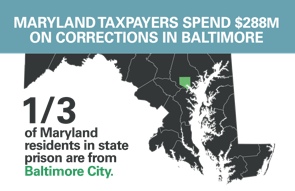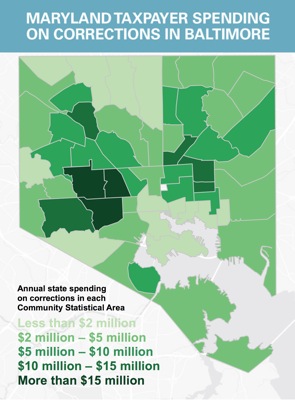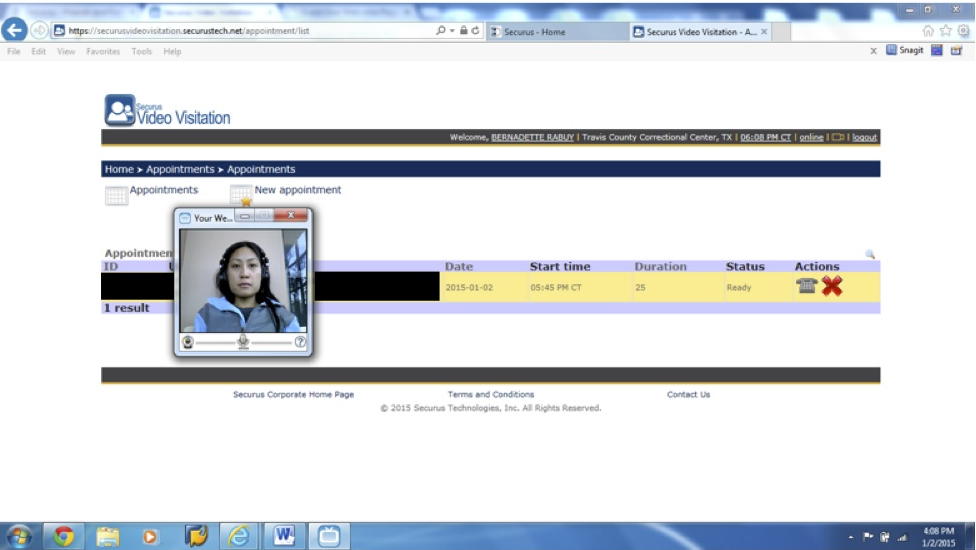John Oliver takes on judicial elections
by Peter Wagner, February 25, 2015
John Oliver on HBO Tonight explains judicial elections and explains how that hurts our justice system. (Warning: NSFW for language.)
by Peter Wagner, February 25, 2015
John Oliver on HBO Tonight explains judicial elections and explains how that hurts our justice system. (Warning: NSFW for language.)
February 25, 2015
Groundbreaking report maps incarceration and spending, suggests more effective alternative investments
CONTACT:
Marie Yeager
717-817-3333
management@rodacreative.com
Washington, DC – According to a new report released today by the Justice Policy Institute and the Prison Policy Initiative, Maryland taxpayers are spending $5 million or more to incarcerate people from each of about half of Baltimore’s communities (25 of 55), with total spending of $288 million a year on incarcerating people from Baltimore in Maryland’s prisons.
 Based on data recently made available by a new Maryland law, The Right Investment?: Corrections Spending in Baltimore City shows for the first time where people who are incarcerated are from, and how much Maryland taxpayers spend on their incarceration. The report includes detailed maps and information that can better inform investment decisions in these communities to help solve long-standing challenges and improve public safety.
Based on data recently made available by a new Maryland law, The Right Investment?: Corrections Spending in Baltimore City shows for the first time where people who are incarcerated are from, and how much Maryland taxpayers spend on their incarceration. The report includes detailed maps and information that can better inform investment decisions in these communities to help solve long-standing challenges and improve public safety.
“Spending $288 million every year to incarcerate people from Baltimore isn’t the right choice for Maryland taxpayers,” said Marc Schindler, executive director of the Justice Policy Institute. “This costly investment in incarceration can decrease public safety, and undermine the ability to redirect funds to better long-term solutions that could prevent crime from happening in the first place, including education, housing, drug treatment and employment opportunities.”
The Right Investment? shows that the 25 Baltimore communities where taxpayers spend $5 million dollars or more on incarceration are also the places that experience disproportionate unemployment, greater reliance on public assistance, higher rates of school absence, higher rates of vacant and abandoned housing, and more addiction challenges. The 25 communities also experience lower life expectancy, lower rates of educational attainment, and lower incomes than the rest of Baltimore. The Right Investment? illustrates how the money currently spent on incarceration could instead be better invested in treatment, housing, education, and employment services in these communities.
 “This report combines never-before analyzed geographic data with key metrics on community well-being to allow policymakers to make informed choices about how best to allocate precious taxpayer resources,” said Peter Wagner, executive director of the Prison Policy Initiative.
“This report combines never-before analyzed geographic data with key metrics on community well-being to allow policymakers to make informed choices about how best to allocate precious taxpayer resources,” said Peter Wagner, executive director of the Prison Policy Initiative.
The report is particularly timely because legislators in Annapolis are currently considering a range of policy proposals that could significantly affect corrections spending. Pending legislation includes proposed bills to reduce mandatory minimum prison sentences, reduce the barriers to getting a job after having been convicted of a crime, and create a council to look specifically at how to reduce spending on corrections and reinvest in strategies to increase public safety and reduce recidivism. Fortunately, a proposal from 2013 that recommended the state spend a half-billion dollars on a new jail for Baltimore City has not been included in the Governor’s proposed budget, though the plan has not been explicitly taken off the table.
“This report should lead to a much more informed discussion on how taxpayer money is being spent in these communities,” said Delegate Jill Carter (D-Baltimore City-41). “Along with passing legislation that we know will help reduce the number of people going to prison, shorten their sentences and reduce criminal justice spending, policymakers and the public need better tools to help measure whether we are making the right investments in these communities.”
The Right Investment? is a collaborative effort between the Justice Policy Institute and the Prison Policy Initiative. This report is based on data and information generated by the state of Maryland and research organizations such as the Baltimore Neighborhood Indicators Alliance. Funding for the study was provided by the Open Society Institute–Baltimore, and other foundations that support the partners.
“I introduced the No Representation Without Population Act to provide better data for redistricting purposes, and I’m now looking forward to using all the data and information generated by this law to directly enlighten future criminal justice policy choices in Maryland”, said Delegate Joseline Peña-Melnyk (D-Prince George’s and Anne Arundel-21), the lead sponsor of the law in the House of Delegates.
The full report includes specific analyses of each of Baltimore’s 55 communities, as well as additional data about the number and rates of people incarcerated in other Maryland communities. A complete version of The Right Investment? is available at https://justicepolicy.org/research/the-right-investment-corrections-spending-in-baltimore-city/ and PrisonPolicy.org/origin/.
For more information, contact Marie Yeager at 717-817-3333 or management@rodacreative.com.
###
The Justice Policy Institute, based in Washington, D.C., is working to reduce the use of incarceration and the justice system and promote policies that improve the well-being of all people and communities. The Prison Policy Initiative, a national organization based in Easthampton, Mass. produces cutting edge research to expose the broader harm of mass criminalization, and then sparks advocacy campaigns to create a more just society. For more information on the partners’ work and publications, visit their websites at www.justicepolicy.org and www.prisonpolicy.org.
by Bernadette Rabuy, February 18, 2015
Our new comedy videos taking on the video visitation industry’s outrageous claims that charging $29.95 for a crappy video visit is “just like Skype” are one of the first products from our new Young Professionals Network.
We’re building a list of working people who want to use their skills to improve our criminal justice system. Historically, most of our volunteer or internship opportunities have been based in our office around regular working hours. But our new network allows less frequent but more focused contributions.
We learn about your skills and then keep you or the whole group informed when interesting opportunities come up. Want to learn more and see examples of past collaborations? Fill out our form and introduce yourself! (MSWord) Then, send the completed form to pwagner [at] prisonpolicy.org.
by Bernadette Rabuy, February 18, 2015
Last month, we released a new report, Screening Out Family Time: The for-profit video visitation industry in prisons and jails. Despite exciting press coverage and a victory in Portland, Oregon, where that sheriff agreed to bring back in-person visits, county jails and private companies are still conspiring to ban traditional family visits.
In response, we collaborated with NYC comedians to challenge the industry’s offensive claim that video visitation is “just like Skype” with 4 short videos. The comedians take on banning in-person visits, the high cost, how hard the systems are to use, and that these services make eye contact difficult.
Watch all 4 videos:
Thank you Siobhan Beasley, Phebe Szatmari, Haldane McFall, Luke Delahanty, Ben Rosen, Ted Alexandro, and Dewey Caddell for showing us that it’s possible to make people laugh while raising awareness about one of the most upsetting “innovations” to hit criminal justice in years.
by Stephen Raher, February 6, 2015
Many prisons and jails, citing budget pressure, are on a constant search for functions that can be outsourced. Facilities hire companies to cook food, provide medical service, and teach classes. One insidious wave of outsourcing that has been growing in popularity is using a contractor to pay incarcerated people money to which they are lawfully entitled. But the prison or jail doesn’t pay for this service—instead, the contractor makes money through imposing exploitative fees on people who have just been released.
When a person leaves jail or prison, they may be entitled to money for a variety of reasons (for example: money in their possession when initially arrested, money earned working in the facility, or money sent by friends and relatives). Facilities used to issue checks or give refunds in cash. But an increasing number of jurisdictions are now giving people their money in the form of pre-paid debit cards (often called “release cards”). These cards are often difficult to use and carry extremely high fees.
In 1968, when new electronic payment systems were in their infancy, Congress passed the Electronic Fund Transfer Act, which was designed to protect consumers who pay or receive money through electronic channels. The Act is implemented by detailed regulations that are currently overseen by the Consumer Financial Protection Bureau (CFPB). Over time the regulations have grown to encompass debit cards, and special protections have been added concerning prepaid debit cards. But because of the way that jails and prisons structure release cards, many of the most important protections do not apply.
In response to general complaints about abusive debit-card practices, the CFPB has announced that it will revise the current rules and has invited public comment. Although the CFPB has not specifically mentioned release cards, the problems arising from prison and jail outsourcing are precisely the type of abuses that the CFPB must hear about.
PPI will be submitting comments to the CFPB, but you can help too. Any individuals or organizations with examples of abusive release-card practices or opinions about whether release cards should be regulated by the CFPB should submit comments before the deadline of March 23, 2015. Anyone can submit comments through the docket on regulations.gov.
(For alternative submission methods, see the original notice in the Federal Register.)
by Aleks Kajstura, February 4, 2015
The simply-titled article Exploiting Inmates by Sukey Lewis in today’s East Bay Express presents a great comprehensive overview of the current problems with the prison and jail phone industry.
Well worth a read, whether you’re new to the issue or looking for a good narrative that ties it all together: Exploiting Inmates
by Bernadette Rabuy, February 3, 2015
I woke up today feeling pretty irked. Back when we were working on our report on the video visitation industry in prisons and jails, I tried to do a Securus video visit with an incarcerated person in Texas. Even though the Securus interface said “Status: Ready,” and I could see my face on the computer screen, I waited for 25 minutes for a video visit that never happened.
As a result, a month ago, I requested a refund from Securus. Since it seemed like I did everything right, I was feeling fairly confident that I’d get a refund. I submitted the refund form a month ago and never heard back. Today, I called, and the automated attendant said I’d have a 4 minute wait, but after 20 minutes I gave up.
And then I noticed this: Securus changed the status of my video visit to “Status: You did not log in for your scheduled visit.” I just so happen to have a screen shot of the Securus website from last month when I was waiting for my visit. Do I look logged in to you?
